Business Law Assignment: Contract, Negligence, and Remedies Analysis
VerifiedAdded on 2021/05/31
|16
|3356
|171
Homework Assignment
AI Summary
This document presents a comprehensive analysis of a business law assignment, addressing two primary scenarios. The first scenario examines contract formation between Susan and Terry, focusing on the postal rule of acceptance and the revocation of offers, referencing the cases of Adams v Lindsell and Byrne v Leon Van Tienhoven. It concludes that a valid contract was formed. The second part delves into the issue of negligence concerning Terry's advice to Kevin regarding investments, evaluating Terry's duty of care, breach of duty, and Kevin's contributory negligence. The assignment then proceeds to a second question involving Florence and Renzo, analyzing issues of misrepresentation in a contract for a cafe sale, referencing the parol evidence rule and cases like Goss V Lord Nugent and Henderson v Arthur. Additionally, it investigates the obligations of Florence to GLO, considering contract violations and misrepresentation. Finally, it examines the remedies available to Florence in both cases, referencing cases like Hadley v Baxendale and Howard Marine v Ogden.
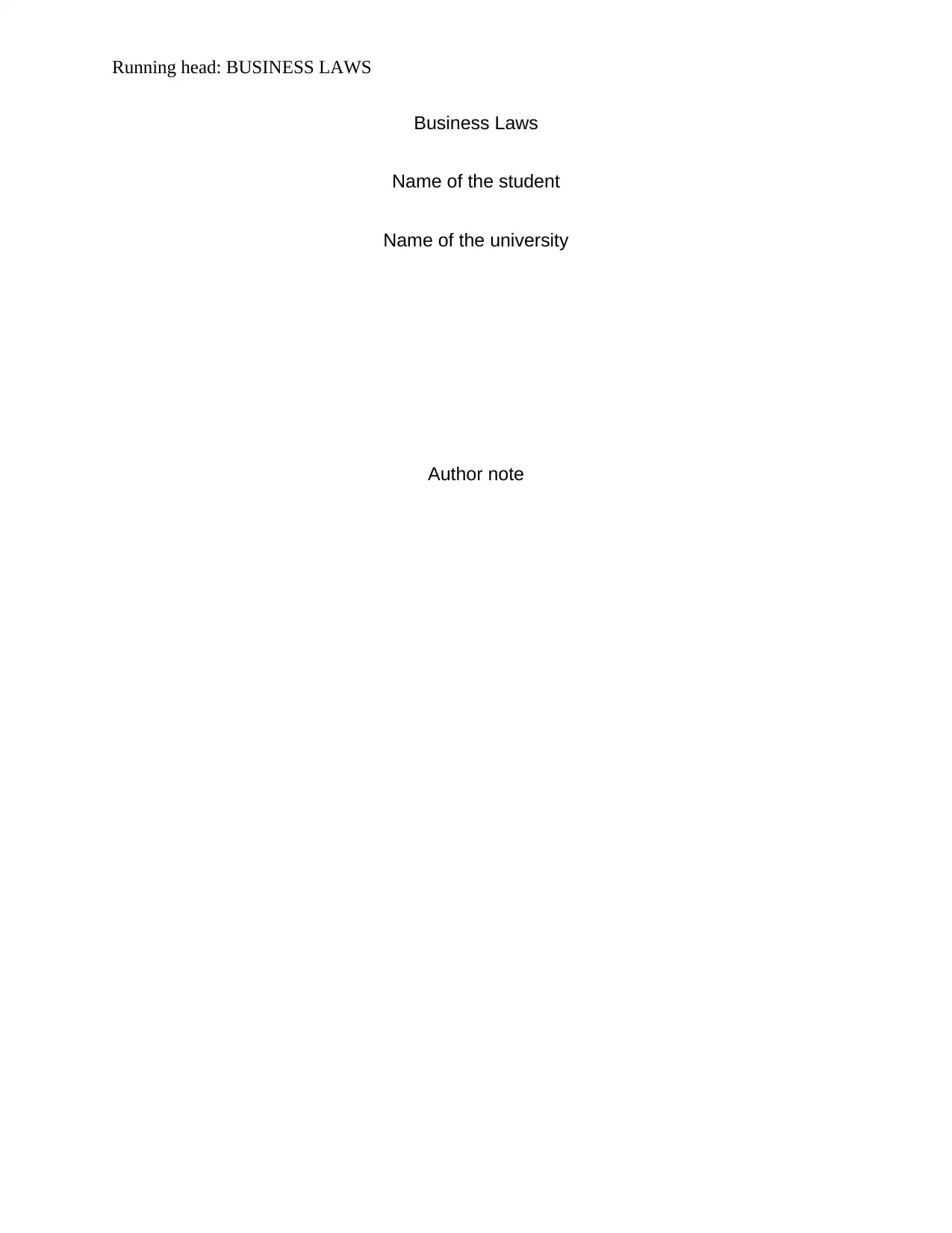
Running head: BUSINESS LAWS
Business Laws
Name of the student
Name of the university
Author note
Business Laws
Name of the student
Name of the university
Author note
Paraphrase This Document
Need a fresh take? Get an instant paraphrase of this document with our AI Paraphraser
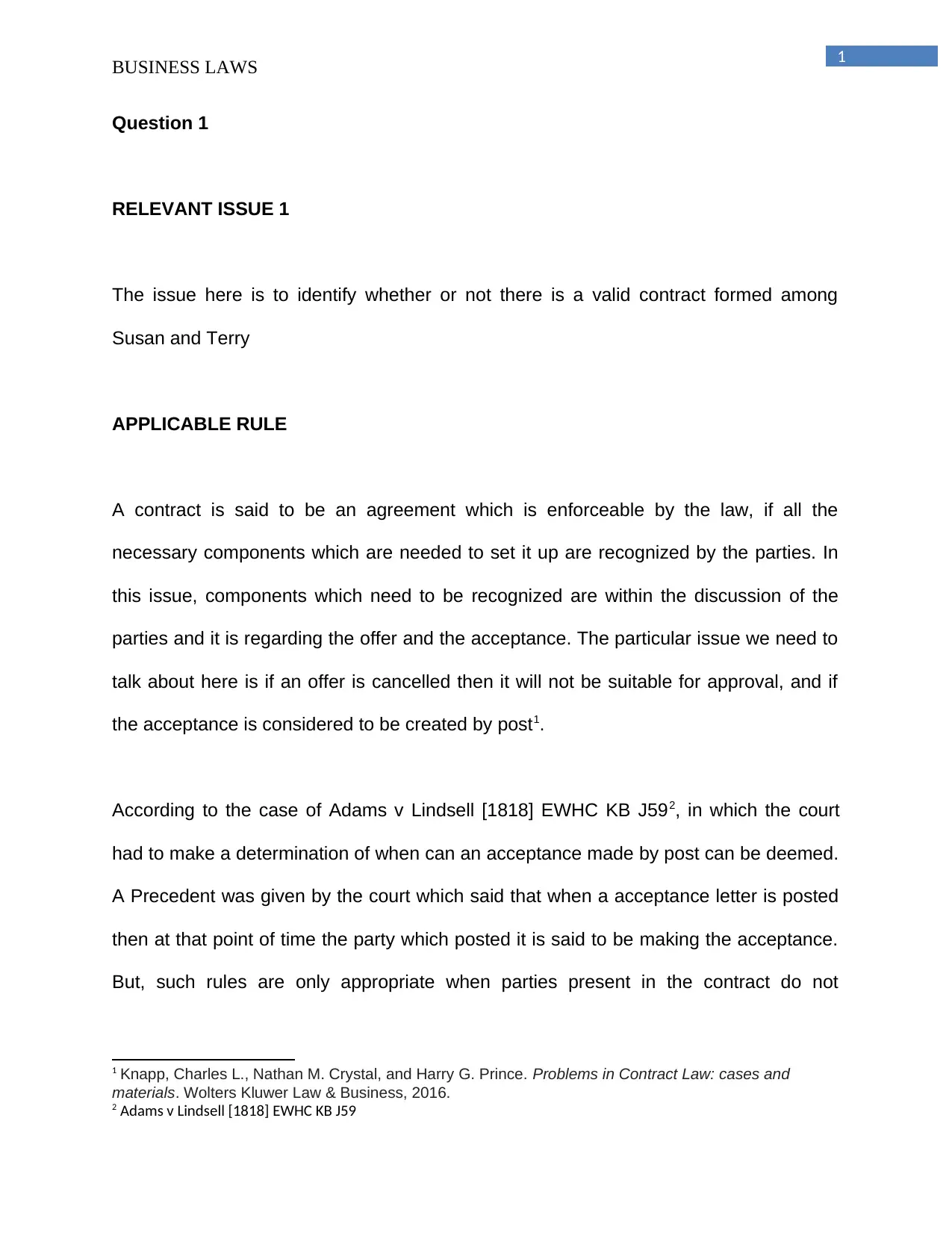
1
BUSINESS LAWS
Question 1
RELEVANT ISSUE 1
The issue here is to identify whether or not there is a valid contract formed among
Susan and Terry
APPLICABLE RULE
A contract is said to be an agreement which is enforceable by the law, if all the
necessary components which are needed to set it up are recognized by the parties. In
this issue, components which need to be recognized are within the discussion of the
parties and it is regarding the offer and the acceptance. The particular issue we need to
talk about here is if an offer is cancelled then it will not be suitable for approval, and if
the acceptance is considered to be created by post1.
According to the case of Adams v Lindsell [1818] EWHC KB J592, in which the court
had to make a determination of when can an acceptance made by post can be deemed.
A Precedent was given by the court which said that when a acceptance letter is posted
then at that point of time the party which posted it is said to be making the acceptance.
But, such rules are only appropriate when parties present in the contract do not
1 Knapp, Charles L., Nathan M. Crystal, and Harry G. Prince. Problems in Contract Law: cases and
materials. Wolters Kluwer Law & Business, 2016.
2 Adams v Lindsell [1818] EWHC KB J59
BUSINESS LAWS
Question 1
RELEVANT ISSUE 1
The issue here is to identify whether or not there is a valid contract formed among
Susan and Terry
APPLICABLE RULE
A contract is said to be an agreement which is enforceable by the law, if all the
necessary components which are needed to set it up are recognized by the parties. In
this issue, components which need to be recognized are within the discussion of the
parties and it is regarding the offer and the acceptance. The particular issue we need to
talk about here is if an offer is cancelled then it will not be suitable for approval, and if
the acceptance is considered to be created by post1.
According to the case of Adams v Lindsell [1818] EWHC KB J592, in which the court
had to make a determination of when can an acceptance made by post can be deemed.
A Precedent was given by the court which said that when a acceptance letter is posted
then at that point of time the party which posted it is said to be making the acceptance.
But, such rules are only appropriate when parties present in the contract do not
1 Knapp, Charles L., Nathan M. Crystal, and Harry G. Prince. Problems in Contract Law: cases and
materials. Wolters Kluwer Law & Business, 2016.
2 Adams v Lindsell [1818] EWHC KB J59
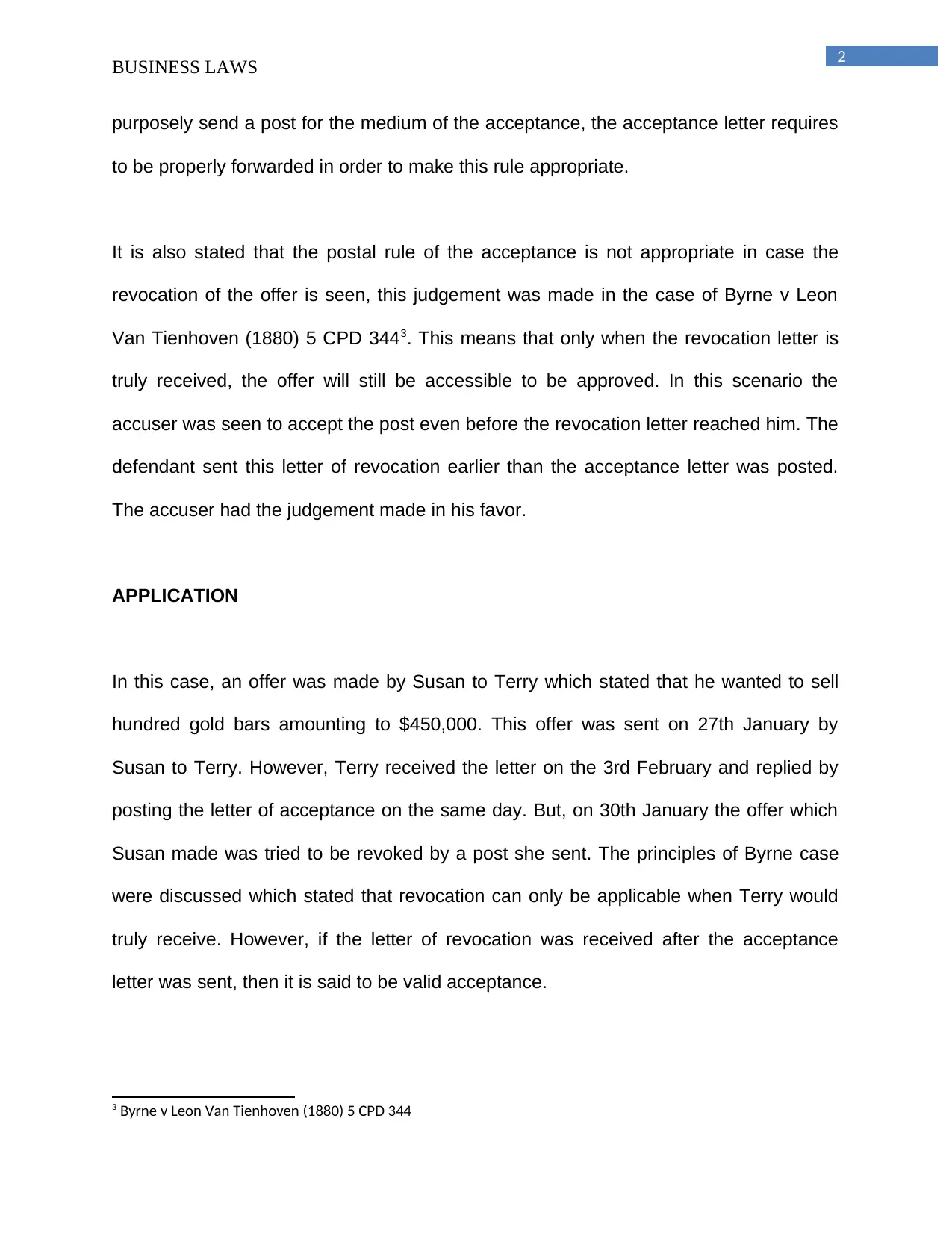
2
BUSINESS LAWS
purposely send a post for the medium of the acceptance, the acceptance letter requires
to be properly forwarded in order to make this rule appropriate.
It is also stated that the postal rule of the acceptance is not appropriate in case the
revocation of the offer is seen, this judgement was made in the case of Byrne v Leon
Van Tienhoven (1880) 5 CPD 3443. This means that only when the revocation letter is
truly received, the offer will still be accessible to be approved. In this scenario the
accuser was seen to accept the post even before the revocation letter reached him. The
defendant sent this letter of revocation earlier than the acceptance letter was posted.
The accuser had the judgement made in his favor.
APPLICATION
In this case, an offer was made by Susan to Terry which stated that he wanted to sell
hundred gold bars amounting to $450,000. This offer was sent on 27th January by
Susan to Terry. However, Terry received the letter on the 3rd February and replied by
posting the letter of acceptance on the same day. But, on 30th January the offer which
Susan made was tried to be revoked by a post she sent. The principles of Byrne case
were discussed which stated that revocation can only be applicable when Terry would
truly receive. However, if the letter of revocation was received after the acceptance
letter was sent, then it is said to be valid acceptance.
3 Byrne v Leon Van Tienhoven (1880) 5 CPD 344
BUSINESS LAWS
purposely send a post for the medium of the acceptance, the acceptance letter requires
to be properly forwarded in order to make this rule appropriate.
It is also stated that the postal rule of the acceptance is not appropriate in case the
revocation of the offer is seen, this judgement was made in the case of Byrne v Leon
Van Tienhoven (1880) 5 CPD 3443. This means that only when the revocation letter is
truly received, the offer will still be accessible to be approved. In this scenario the
accuser was seen to accept the post even before the revocation letter reached him. The
defendant sent this letter of revocation earlier than the acceptance letter was posted.
The accuser had the judgement made in his favor.
APPLICATION
In this case, an offer was made by Susan to Terry which stated that he wanted to sell
hundred gold bars amounting to $450,000. This offer was sent on 27th January by
Susan to Terry. However, Terry received the letter on the 3rd February and replied by
posting the letter of acceptance on the same day. But, on 30th January the offer which
Susan made was tried to be revoked by a post she sent. The principles of Byrne case
were discussed which stated that revocation can only be applicable when Terry would
truly receive. However, if the letter of revocation was received after the acceptance
letter was sent, then it is said to be valid acceptance.
3 Byrne v Leon Van Tienhoven (1880) 5 CPD 344
⊘ This is a preview!⊘
Do you want full access?
Subscribe today to unlock all pages.

Trusted by 1+ million students worldwide
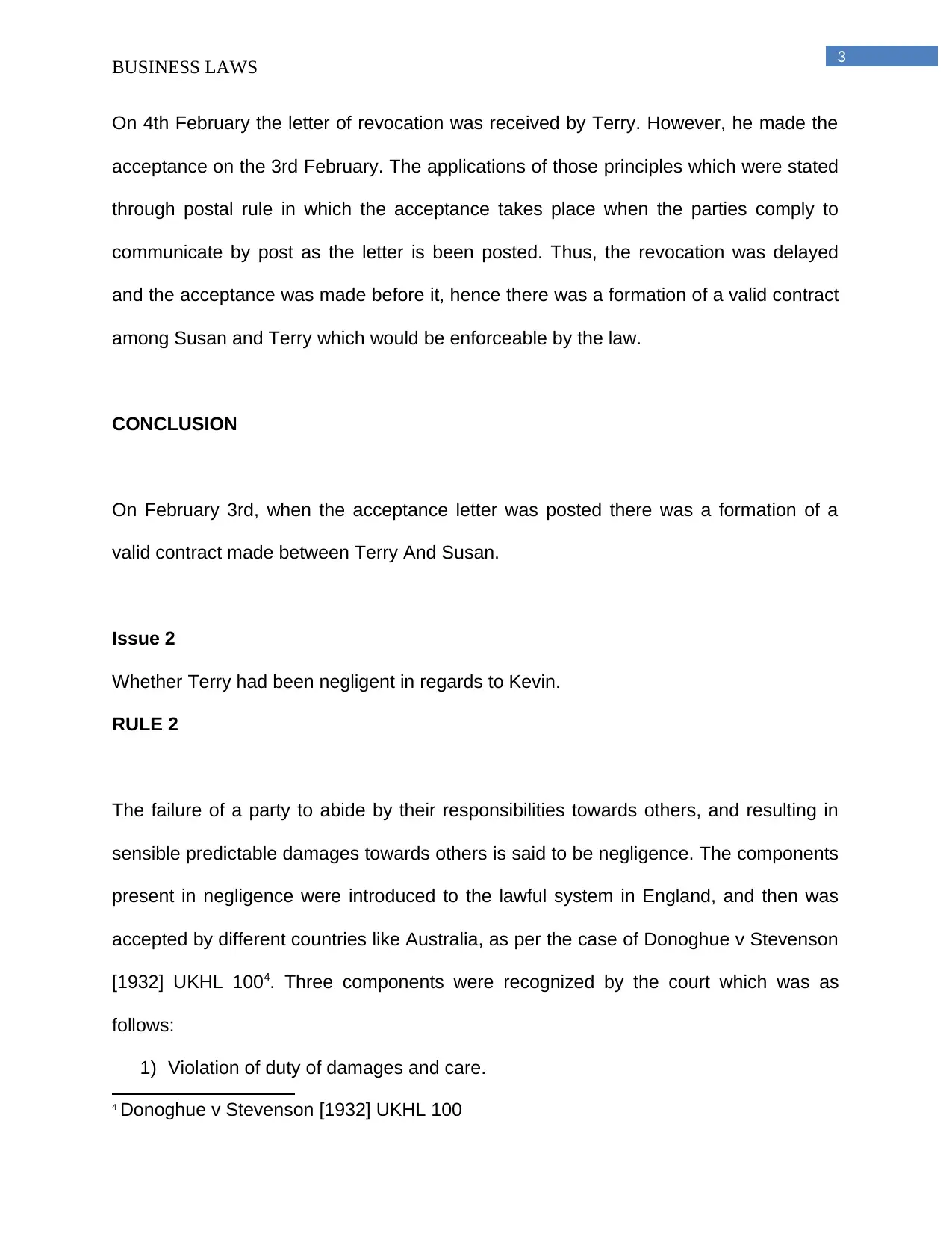
3
BUSINESS LAWS
On 4th February the letter of revocation was received by Terry. However, he made the
acceptance on the 3rd February. The applications of those principles which were stated
through postal rule in which the acceptance takes place when the parties comply to
communicate by post as the letter is been posted. Thus, the revocation was delayed
and the acceptance was made before it, hence there was a formation of a valid contract
among Susan and Terry which would be enforceable by the law.
CONCLUSION
On February 3rd, when the acceptance letter was posted there was a formation of a
valid contract made between Terry And Susan.
Issue 2
Whether Terry had been negligent in regards to Kevin.
RULE 2
The failure of a party to abide by their responsibilities towards others, and resulting in
sensible predictable damages towards others is said to be negligence. The components
present in negligence were introduced to the lawful system in England, and then was
accepted by different countries like Australia, as per the case of Donoghue v Stevenson
[1932] UKHL 1004. Three components were recognized by the court which was as
follows:
1) Violation of duty of damages and care.
4 Donoghue v Stevenson [1932] UKHL 100
BUSINESS LAWS
On 4th February the letter of revocation was received by Terry. However, he made the
acceptance on the 3rd February. The applications of those principles which were stated
through postal rule in which the acceptance takes place when the parties comply to
communicate by post as the letter is been posted. Thus, the revocation was delayed
and the acceptance was made before it, hence there was a formation of a valid contract
among Susan and Terry which would be enforceable by the law.
CONCLUSION
On February 3rd, when the acceptance letter was posted there was a formation of a
valid contract made between Terry And Susan.
Issue 2
Whether Terry had been negligent in regards to Kevin.
RULE 2
The failure of a party to abide by their responsibilities towards others, and resulting in
sensible predictable damages towards others is said to be negligence. The components
present in negligence were introduced to the lawful system in England, and then was
accepted by different countries like Australia, as per the case of Donoghue v Stevenson
[1932] UKHL 1004. Three components were recognized by the court which was as
follows:
1) Violation of duty of damages and care.
4 Donoghue v Stevenson [1932] UKHL 100
Paraphrase This Document
Need a fresh take? Get an instant paraphrase of this document with our AI Paraphraser
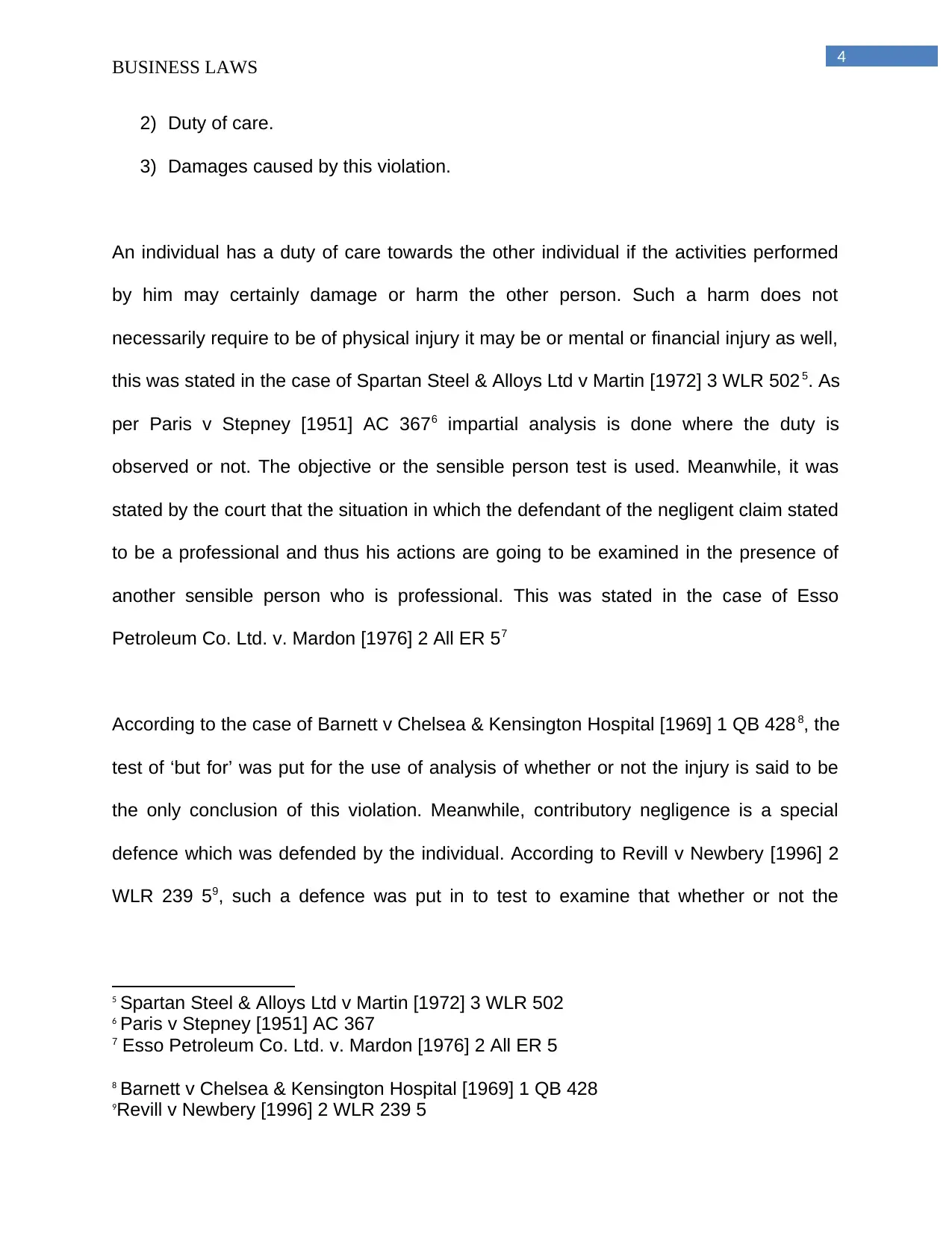
4
BUSINESS LAWS
2) Duty of care.
3) Damages caused by this violation.
An individual has a duty of care towards the other individual if the activities performed
by him may certainly damage or harm the other person. Such a harm does not
necessarily require to be of physical injury it may be or mental or financial injury as well,
this was stated in the case of Spartan Steel & Alloys Ltd v Martin [1972] 3 WLR 502 5. As
per Paris v Stepney [1951] AC 3676 impartial analysis is done where the duty is
observed or not. The objective or the sensible person test is used. Meanwhile, it was
stated by the court that the situation in which the defendant of the negligent claim stated
to be a professional and thus his actions are going to be examined in the presence of
another sensible person who is professional. This was stated in the case of Esso
Petroleum Co. Ltd. v. Mardon [1976] 2 All ER 57
According to the case of Barnett v Chelsea & Kensington Hospital [1969] 1 QB 428 8, the
test of ‘but for’ was put for the use of analysis of whether or not the injury is said to be
the only conclusion of this violation. Meanwhile, contributory negligence is a special
defence which was defended by the individual. According to Revill v Newbery [1996] 2
WLR 239 59, such a defence was put in to test to examine that whether or not the
5 Spartan Steel & Alloys Ltd v Martin [1972] 3 WLR 502
6 Paris v Stepney [1951] AC 367
7 Esso Petroleum Co. Ltd. v. Mardon [1976] 2 All ER 5
8 Barnett v Chelsea & Kensington Hospital [1969] 1 QB 428
9Revill v Newbery [1996] 2 WLR 239 5
BUSINESS LAWS
2) Duty of care.
3) Damages caused by this violation.
An individual has a duty of care towards the other individual if the activities performed
by him may certainly damage or harm the other person. Such a harm does not
necessarily require to be of physical injury it may be or mental or financial injury as well,
this was stated in the case of Spartan Steel & Alloys Ltd v Martin [1972] 3 WLR 502 5. As
per Paris v Stepney [1951] AC 3676 impartial analysis is done where the duty is
observed or not. The objective or the sensible person test is used. Meanwhile, it was
stated by the court that the situation in which the defendant of the negligent claim stated
to be a professional and thus his actions are going to be examined in the presence of
another sensible person who is professional. This was stated in the case of Esso
Petroleum Co. Ltd. v. Mardon [1976] 2 All ER 57
According to the case of Barnett v Chelsea & Kensington Hospital [1969] 1 QB 428 8, the
test of ‘but for’ was put for the use of analysis of whether or not the injury is said to be
the only conclusion of this violation. Meanwhile, contributory negligence is a special
defence which was defended by the individual. According to Revill v Newbery [1996] 2
WLR 239 59, such a defence was put in to test to examine that whether or not the
5 Spartan Steel & Alloys Ltd v Martin [1972] 3 WLR 502
6 Paris v Stepney [1951] AC 367
7 Esso Petroleum Co. Ltd. v. Mardon [1976] 2 All ER 5
8 Barnett v Chelsea & Kensington Hospital [1969] 1 QB 428
9Revill v Newbery [1996] 2 WLR 239 5
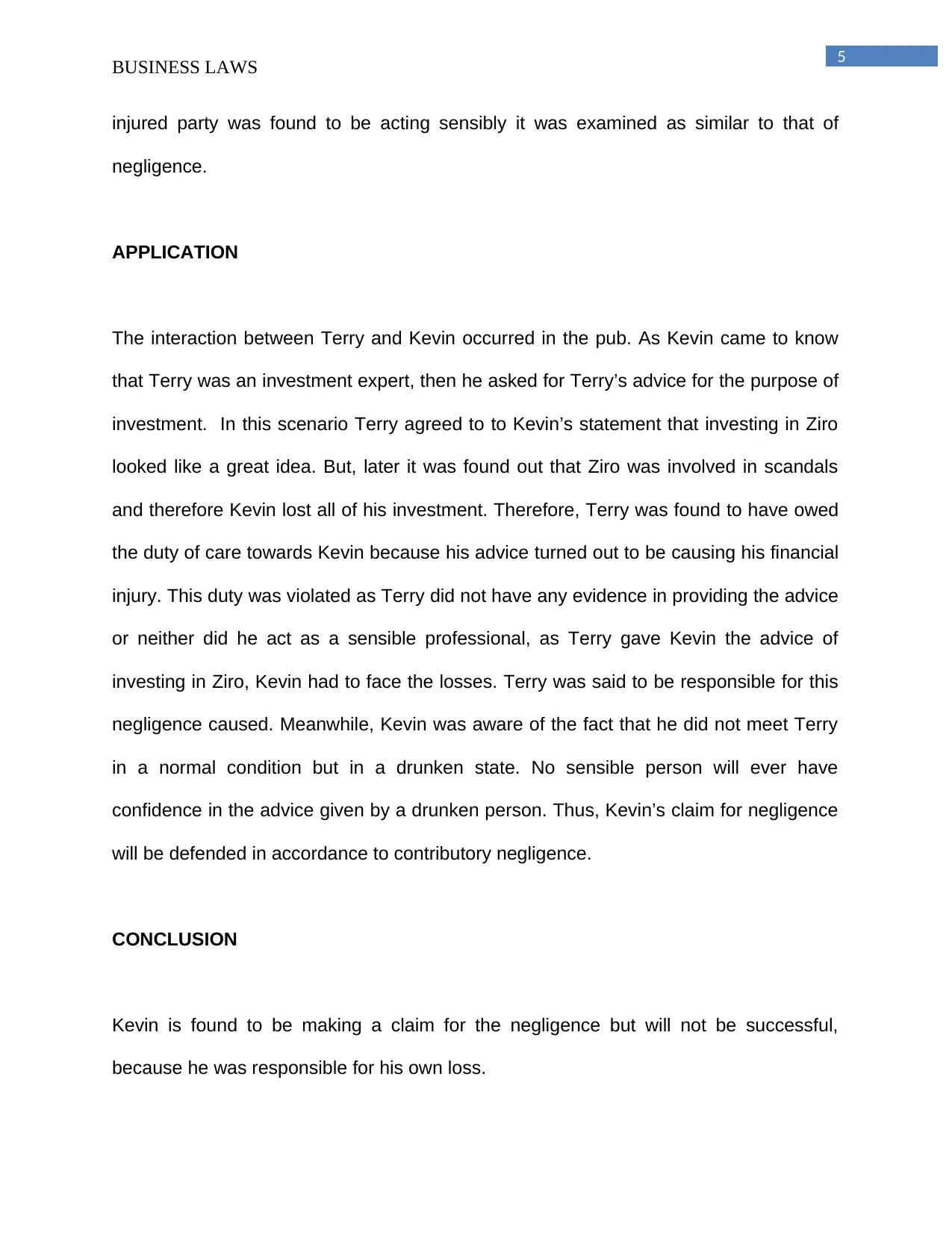
5
BUSINESS LAWS
injured party was found to be acting sensibly it was examined as similar to that of
negligence.
APPLICATION
The interaction between Terry and Kevin occurred in the pub. As Kevin came to know
that Terry was an investment expert, then he asked for Terry’s advice for the purpose of
investment. In this scenario Terry agreed to to Kevin’s statement that investing in Ziro
looked like a great idea. But, later it was found out that Ziro was involved in scandals
and therefore Kevin lost all of his investment. Therefore, Terry was found to have owed
the duty of care towards Kevin because his advice turned out to be causing his financial
injury. This duty was violated as Terry did not have any evidence in providing the advice
or neither did he act as a sensible professional, as Terry gave Kevin the advice of
investing in Ziro, Kevin had to face the losses. Terry was said to be responsible for this
negligence caused. Meanwhile, Kevin was aware of the fact that he did not meet Terry
in a normal condition but in a drunken state. No sensible person will ever have
confidence in the advice given by a drunken person. Thus, Kevin’s claim for negligence
will be defended in accordance to contributory negligence.
CONCLUSION
Kevin is found to be making a claim for the negligence but will not be successful,
because he was responsible for his own loss.
BUSINESS LAWS
injured party was found to be acting sensibly it was examined as similar to that of
negligence.
APPLICATION
The interaction between Terry and Kevin occurred in the pub. As Kevin came to know
that Terry was an investment expert, then he asked for Terry’s advice for the purpose of
investment. In this scenario Terry agreed to to Kevin’s statement that investing in Ziro
looked like a great idea. But, later it was found out that Ziro was involved in scandals
and therefore Kevin lost all of his investment. Therefore, Terry was found to have owed
the duty of care towards Kevin because his advice turned out to be causing his financial
injury. This duty was violated as Terry did not have any evidence in providing the advice
or neither did he act as a sensible professional, as Terry gave Kevin the advice of
investing in Ziro, Kevin had to face the losses. Terry was said to be responsible for this
negligence caused. Meanwhile, Kevin was aware of the fact that he did not meet Terry
in a normal condition but in a drunken state. No sensible person will ever have
confidence in the advice given by a drunken person. Thus, Kevin’s claim for negligence
will be defended in accordance to contributory negligence.
CONCLUSION
Kevin is found to be making a claim for the negligence but will not be successful,
because he was responsible for his own loss.
⊘ This is a preview!⊘
Do you want full access?
Subscribe today to unlock all pages.

Trusted by 1+ million students worldwide
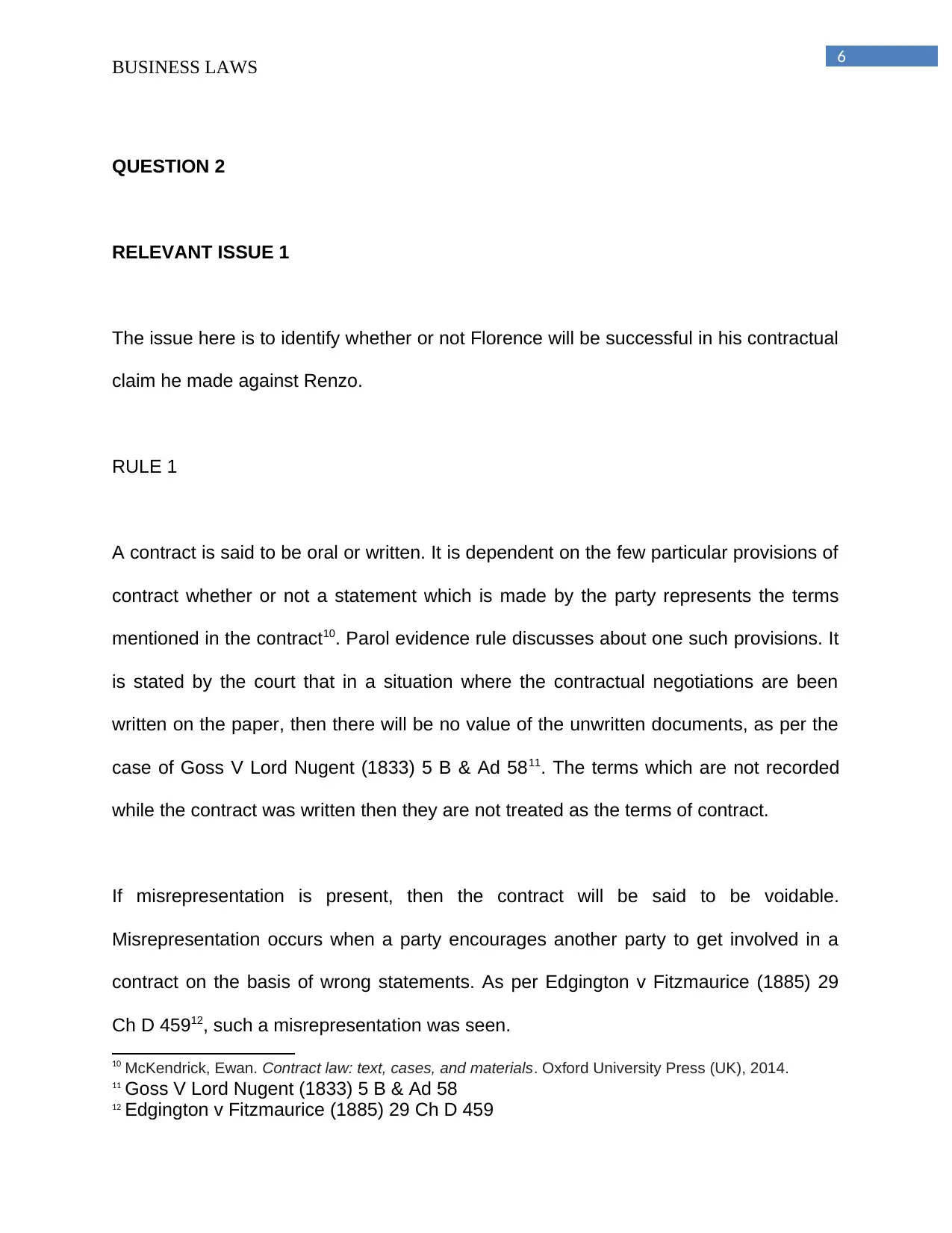
6
BUSINESS LAWS
QUESTION 2
RELEVANT ISSUE 1
The issue here is to identify whether or not Florence will be successful in his contractual
claim he made against Renzo.
RULE 1
A contract is said to be oral or written. It is dependent on the few particular provisions of
contract whether or not a statement which is made by the party represents the terms
mentioned in the contract10. Parol evidence rule discusses about one such provisions. It
is stated by the court that in a situation where the contractual negotiations are been
written on the paper, then there will be no value of the unwritten documents, as per the
case of Goss V Lord Nugent (1833) 5 B & Ad 5811. The terms which are not recorded
while the contract was written then they are not treated as the terms of contract.
If misrepresentation is present, then the contract will be said to be voidable.
Misrepresentation occurs when a party encourages another party to get involved in a
contract on the basis of wrong statements. As per Edgington v Fitzmaurice (1885) 29
Ch D 45912, such a misrepresentation was seen.
10 McKendrick, Ewan. Contract law: text, cases, and materials. Oxford University Press (UK), 2014.
11 Goss V Lord Nugent (1833) 5 B & Ad 58
12 Edgington v Fitzmaurice (1885) 29 Ch D 459
BUSINESS LAWS
QUESTION 2
RELEVANT ISSUE 1
The issue here is to identify whether or not Florence will be successful in his contractual
claim he made against Renzo.
RULE 1
A contract is said to be oral or written. It is dependent on the few particular provisions of
contract whether or not a statement which is made by the party represents the terms
mentioned in the contract10. Parol evidence rule discusses about one such provisions. It
is stated by the court that in a situation where the contractual negotiations are been
written on the paper, then there will be no value of the unwritten documents, as per the
case of Goss V Lord Nugent (1833) 5 B & Ad 5811. The terms which are not recorded
while the contract was written then they are not treated as the terms of contract.
If misrepresentation is present, then the contract will be said to be voidable.
Misrepresentation occurs when a party encourages another party to get involved in a
contract on the basis of wrong statements. As per Edgington v Fitzmaurice (1885) 29
Ch D 45912, such a misrepresentation was seen.
10 McKendrick, Ewan. Contract law: text, cases, and materials. Oxford University Press (UK), 2014.
11 Goss V Lord Nugent (1833) 5 B & Ad 58
12 Edgington v Fitzmaurice (1885) 29 Ch D 459
Paraphrase This Document
Need a fresh take? Get an instant paraphrase of this document with our AI Paraphraser
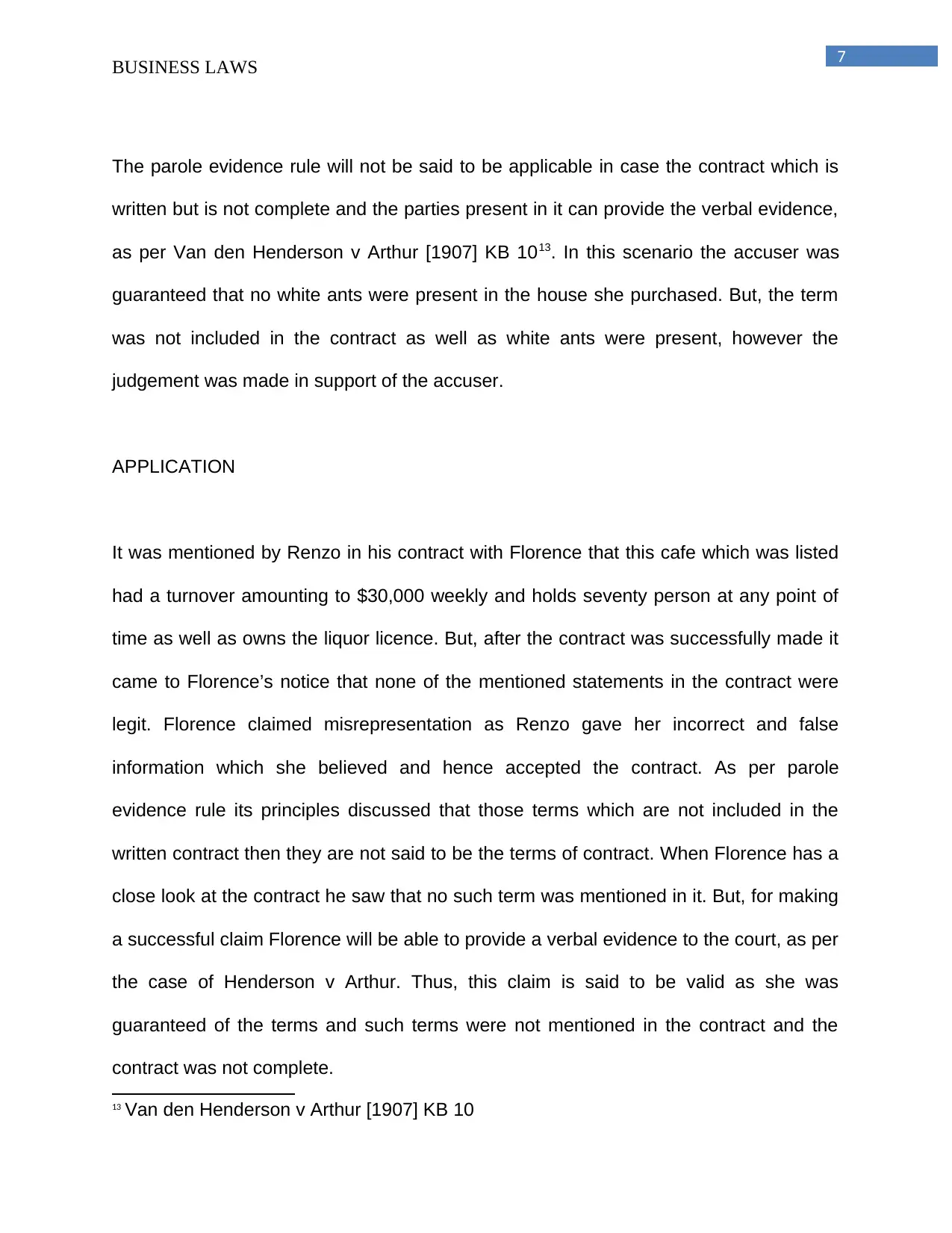
7
BUSINESS LAWS
The parole evidence rule will not be said to be applicable in case the contract which is
written but is not complete and the parties present in it can provide the verbal evidence,
as per Van den Henderson v Arthur [1907] KB 1013. In this scenario the accuser was
guaranteed that no white ants were present in the house she purchased. But, the term
was not included in the contract as well as white ants were present, however the
judgement was made in support of the accuser.
APPLICATION
It was mentioned by Renzo in his contract with Florence that this cafe which was listed
had a turnover amounting to $30,000 weekly and holds seventy person at any point of
time as well as owns the liquor licence. But, after the contract was successfully made it
came to Florence’s notice that none of the mentioned statements in the contract were
legit. Florence claimed misrepresentation as Renzo gave her incorrect and false
information which she believed and hence accepted the contract. As per parole
evidence rule its principles discussed that those terms which are not included in the
written contract then they are not said to be the terms of contract. When Florence has a
close look at the contract he saw that no such term was mentioned in it. But, for making
a successful claim Florence will be able to provide a verbal evidence to the court, as per
the case of Henderson v Arthur. Thus, this claim is said to be valid as she was
guaranteed of the terms and such terms were not mentioned in the contract and the
contract was not complete.
13 Van den Henderson v Arthur [1907] KB 10
BUSINESS LAWS
The parole evidence rule will not be said to be applicable in case the contract which is
written but is not complete and the parties present in it can provide the verbal evidence,
as per Van den Henderson v Arthur [1907] KB 1013. In this scenario the accuser was
guaranteed that no white ants were present in the house she purchased. But, the term
was not included in the contract as well as white ants were present, however the
judgement was made in support of the accuser.
APPLICATION
It was mentioned by Renzo in his contract with Florence that this cafe which was listed
had a turnover amounting to $30,000 weekly and holds seventy person at any point of
time as well as owns the liquor licence. But, after the contract was successfully made it
came to Florence’s notice that none of the mentioned statements in the contract were
legit. Florence claimed misrepresentation as Renzo gave her incorrect and false
information which she believed and hence accepted the contract. As per parole
evidence rule its principles discussed that those terms which are not included in the
written contract then they are not said to be the terms of contract. When Florence has a
close look at the contract he saw that no such term was mentioned in it. But, for making
a successful claim Florence will be able to provide a verbal evidence to the court, as per
the case of Henderson v Arthur. Thus, this claim is said to be valid as she was
guaranteed of the terms and such terms were not mentioned in the contract and the
contract was not complete.
13 Van den Henderson v Arthur [1907] KB 10
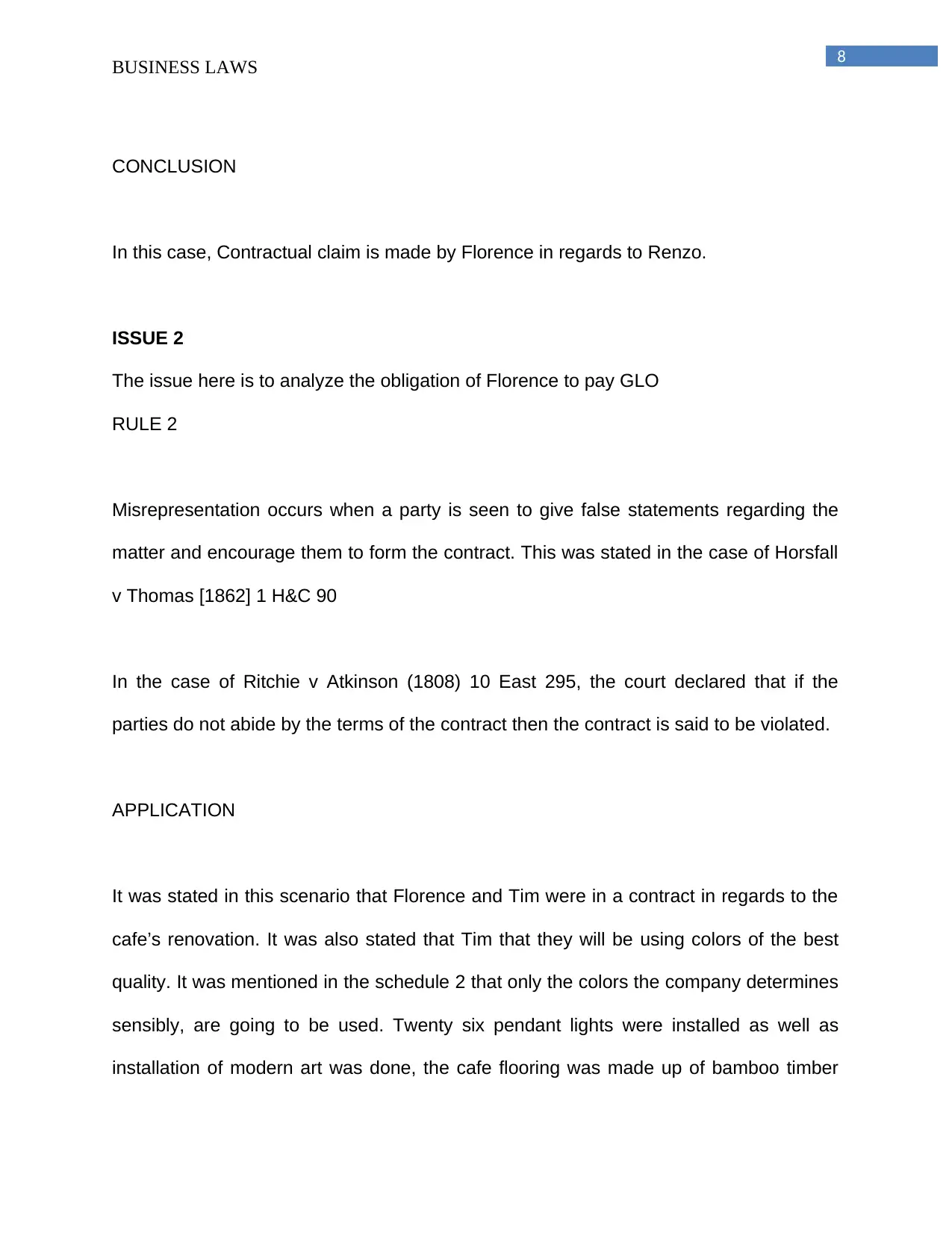
8
BUSINESS LAWS
CONCLUSION
In this case, Contractual claim is made by Florence in regards to Renzo.
ISSUE 2
The issue here is to analyze the obligation of Florence to pay GLO
RULE 2
Misrepresentation occurs when a party is seen to give false statements regarding the
matter and encourage them to form the contract. This was stated in the case of Horsfall
v Thomas [1862] 1 H&C 90
In the case of Ritchie v Atkinson (1808) 10 East 295, the court declared that if the
parties do not abide by the terms of the contract then the contract is said to be violated.
APPLICATION
It was stated in this scenario that Florence and Tim were in a contract in regards to the
cafe’s renovation. It was also stated that Tim that they will be using colors of the best
quality. It was mentioned in the schedule 2 that only the colors the company determines
sensibly, are going to be used. Twenty six pendant lights were installed as well as
installation of modern art was done, the cafe flooring was made up of bamboo timber
BUSINESS LAWS
CONCLUSION
In this case, Contractual claim is made by Florence in regards to Renzo.
ISSUE 2
The issue here is to analyze the obligation of Florence to pay GLO
RULE 2
Misrepresentation occurs when a party is seen to give false statements regarding the
matter and encourage them to form the contract. This was stated in the case of Horsfall
v Thomas [1862] 1 H&C 90
In the case of Ritchie v Atkinson (1808) 10 East 295, the court declared that if the
parties do not abide by the terms of the contract then the contract is said to be violated.
APPLICATION
It was stated in this scenario that Florence and Tim were in a contract in regards to the
cafe’s renovation. It was also stated that Tim that they will be using colors of the best
quality. It was mentioned in the schedule 2 that only the colors the company determines
sensibly, are going to be used. Twenty six pendant lights were installed as well as
installation of modern art was done, the cafe flooring was made up of bamboo timber
⊘ This is a preview!⊘
Do you want full access?
Subscribe today to unlock all pages.

Trusted by 1+ million students worldwide
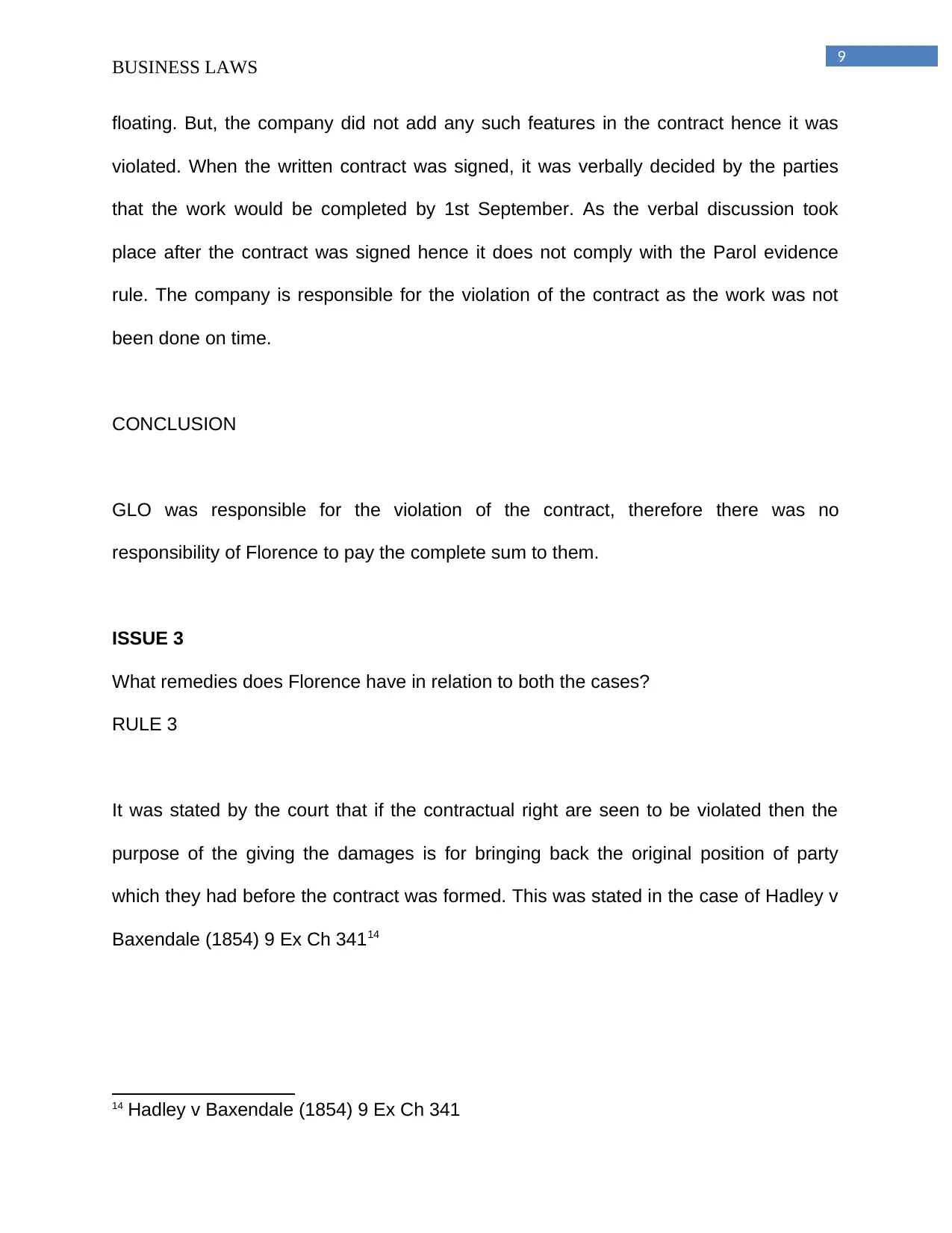
9
BUSINESS LAWS
floating. But, the company did not add any such features in the contract hence it was
violated. When the written contract was signed, it was verbally decided by the parties
that the work would be completed by 1st September. As the verbal discussion took
place after the contract was signed hence it does not comply with the Parol evidence
rule. The company is responsible for the violation of the contract as the work was not
been done on time.
CONCLUSION
GLO was responsible for the violation of the contract, therefore there was no
responsibility of Florence to pay the complete sum to them.
ISSUE 3
What remedies does Florence have in relation to both the cases?
RULE 3
It was stated by the court that if the contractual right are seen to be violated then the
purpose of the giving the damages is for bringing back the original position of party
which they had before the contract was formed. This was stated in the case of Hadley v
Baxendale (1854) 9 Ex Ch 34114
14 Hadley v Baxendale (1854) 9 Ex Ch 341
BUSINESS LAWS
floating. But, the company did not add any such features in the contract hence it was
violated. When the written contract was signed, it was verbally decided by the parties
that the work would be completed by 1st September. As the verbal discussion took
place after the contract was signed hence it does not comply with the Parol evidence
rule. The company is responsible for the violation of the contract as the work was not
been done on time.
CONCLUSION
GLO was responsible for the violation of the contract, therefore there was no
responsibility of Florence to pay the complete sum to them.
ISSUE 3
What remedies does Florence have in relation to both the cases?
RULE 3
It was stated by the court that if the contractual right are seen to be violated then the
purpose of the giving the damages is for bringing back the original position of party
which they had before the contract was formed. This was stated in the case of Hadley v
Baxendale (1854) 9 Ex Ch 34114
14 Hadley v Baxendale (1854) 9 Ex Ch 341
Paraphrase This Document
Need a fresh take? Get an instant paraphrase of this document with our AI Paraphraser
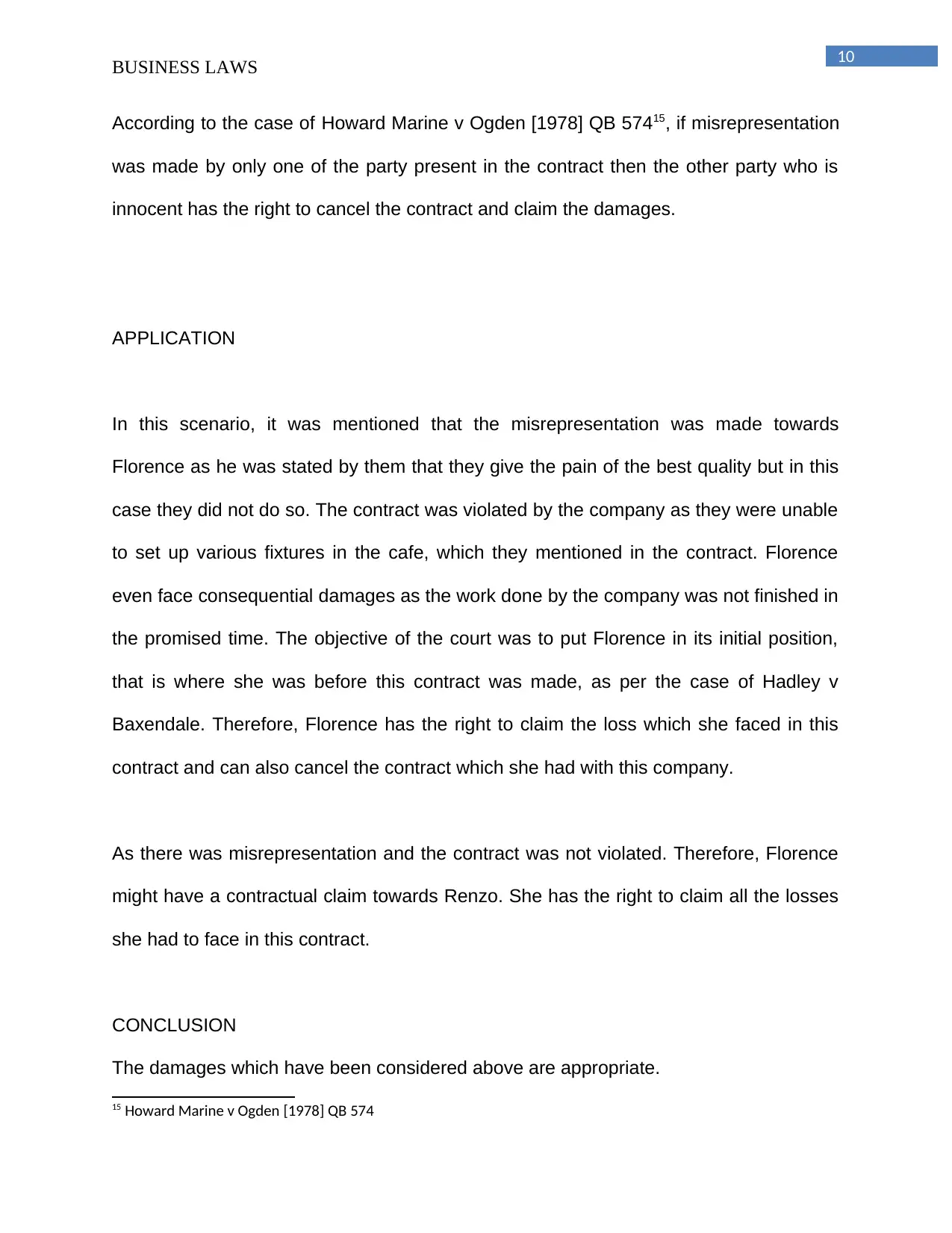
10
BUSINESS LAWS
According to the case of Howard Marine v Ogden [1978] QB 57415, if misrepresentation
was made by only one of the party present in the contract then the other party who is
innocent has the right to cancel the contract and claim the damages.
APPLICATION
In this scenario, it was mentioned that the misrepresentation was made towards
Florence as he was stated by them that they give the pain of the best quality but in this
case they did not do so. The contract was violated by the company as they were unable
to set up various fixtures in the cafe, which they mentioned in the contract. Florence
even face consequential damages as the work done by the company was not finished in
the promised time. The objective of the court was to put Florence in its initial position,
that is where she was before this contract was made, as per the case of Hadley v
Baxendale. Therefore, Florence has the right to claim the loss which she faced in this
contract and can also cancel the contract which she had with this company.
As there was misrepresentation and the contract was not violated. Therefore, Florence
might have a contractual claim towards Renzo. She has the right to claim all the losses
she had to face in this contract.
CONCLUSION
The damages which have been considered above are appropriate.
15 Howard Marine v Ogden [1978] QB 574
BUSINESS LAWS
According to the case of Howard Marine v Ogden [1978] QB 57415, if misrepresentation
was made by only one of the party present in the contract then the other party who is
innocent has the right to cancel the contract and claim the damages.
APPLICATION
In this scenario, it was mentioned that the misrepresentation was made towards
Florence as he was stated by them that they give the pain of the best quality but in this
case they did not do so. The contract was violated by the company as they were unable
to set up various fixtures in the cafe, which they mentioned in the contract. Florence
even face consequential damages as the work done by the company was not finished in
the promised time. The objective of the court was to put Florence in its initial position,
that is where she was before this contract was made, as per the case of Hadley v
Baxendale. Therefore, Florence has the right to claim the loss which she faced in this
contract and can also cancel the contract which she had with this company.
As there was misrepresentation and the contract was not violated. Therefore, Florence
might have a contractual claim towards Renzo. She has the right to claim all the losses
she had to face in this contract.
CONCLUSION
The damages which have been considered above are appropriate.
15 Howard Marine v Ogden [1978] QB 574
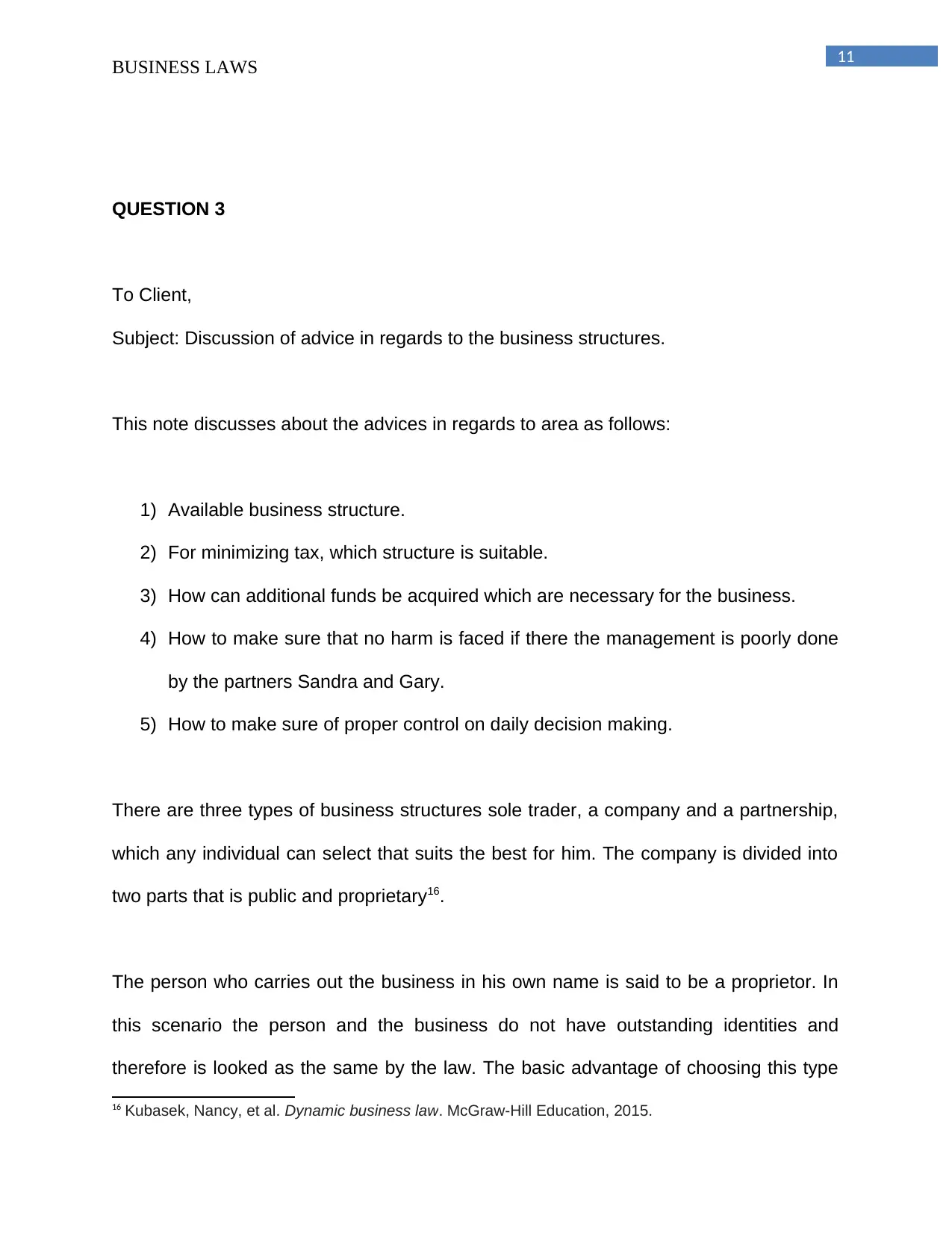
11
BUSINESS LAWS
QUESTION 3
To Client,
Subject: Discussion of advice in regards to the business structures.
This note discusses about the advices in regards to area as follows:
1) Available business structure.
2) For minimizing tax, which structure is suitable.
3) How can additional funds be acquired which are necessary for the business.
4) How to make sure that no harm is faced if there the management is poorly done
by the partners Sandra and Gary.
5) How to make sure of proper control on daily decision making.
There are three types of business structures sole trader, a company and a partnership,
which any individual can select that suits the best for him. The company is divided into
two parts that is public and proprietary16.
The person who carries out the business in his own name is said to be a proprietor. In
this scenario the person and the business do not have outstanding identities and
therefore is looked as the same by the law. The basic advantage of choosing this type
16 Kubasek, Nancy, et al. Dynamic business law. McGraw-Hill Education, 2015.
BUSINESS LAWS
QUESTION 3
To Client,
Subject: Discussion of advice in regards to the business structures.
This note discusses about the advices in regards to area as follows:
1) Available business structure.
2) For minimizing tax, which structure is suitable.
3) How can additional funds be acquired which are necessary for the business.
4) How to make sure that no harm is faced if there the management is poorly done
by the partners Sandra and Gary.
5) How to make sure of proper control on daily decision making.
There are three types of business structures sole trader, a company and a partnership,
which any individual can select that suits the best for him. The company is divided into
two parts that is public and proprietary16.
The person who carries out the business in his own name is said to be a proprietor. In
this scenario the person and the business do not have outstanding identities and
therefore is looked as the same by the law. The basic advantage of choosing this type
16 Kubasek, Nancy, et al. Dynamic business law. McGraw-Hill Education, 2015.
⊘ This is a preview!⊘
Do you want full access?
Subscribe today to unlock all pages.

Trusted by 1+ million students worldwide
1 out of 16
Related Documents
Your All-in-One AI-Powered Toolkit for Academic Success.
+13062052269
info@desklib.com
Available 24*7 on WhatsApp / Email
![[object Object]](/_next/static/media/star-bottom.7253800d.svg)
Unlock your academic potential
Copyright © 2020–2025 A2Z Services. All Rights Reserved. Developed and managed by ZUCOL.





